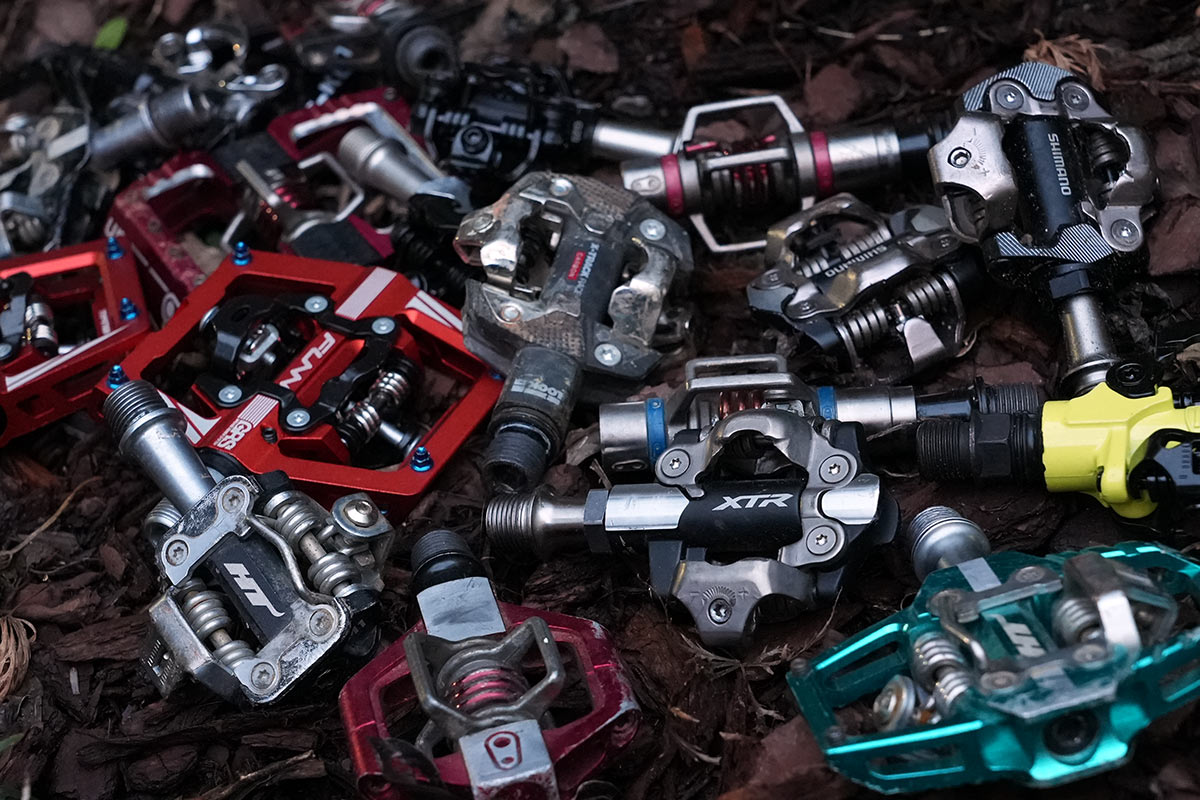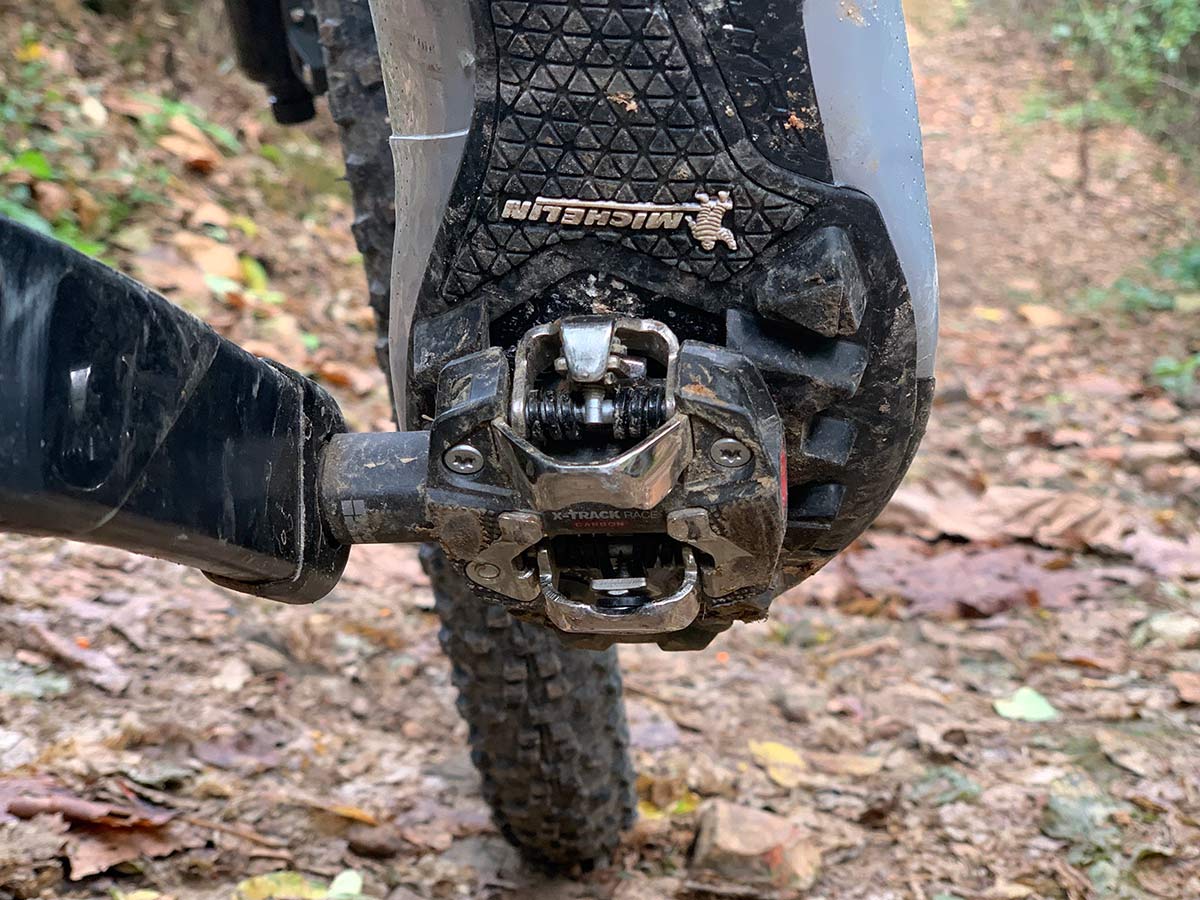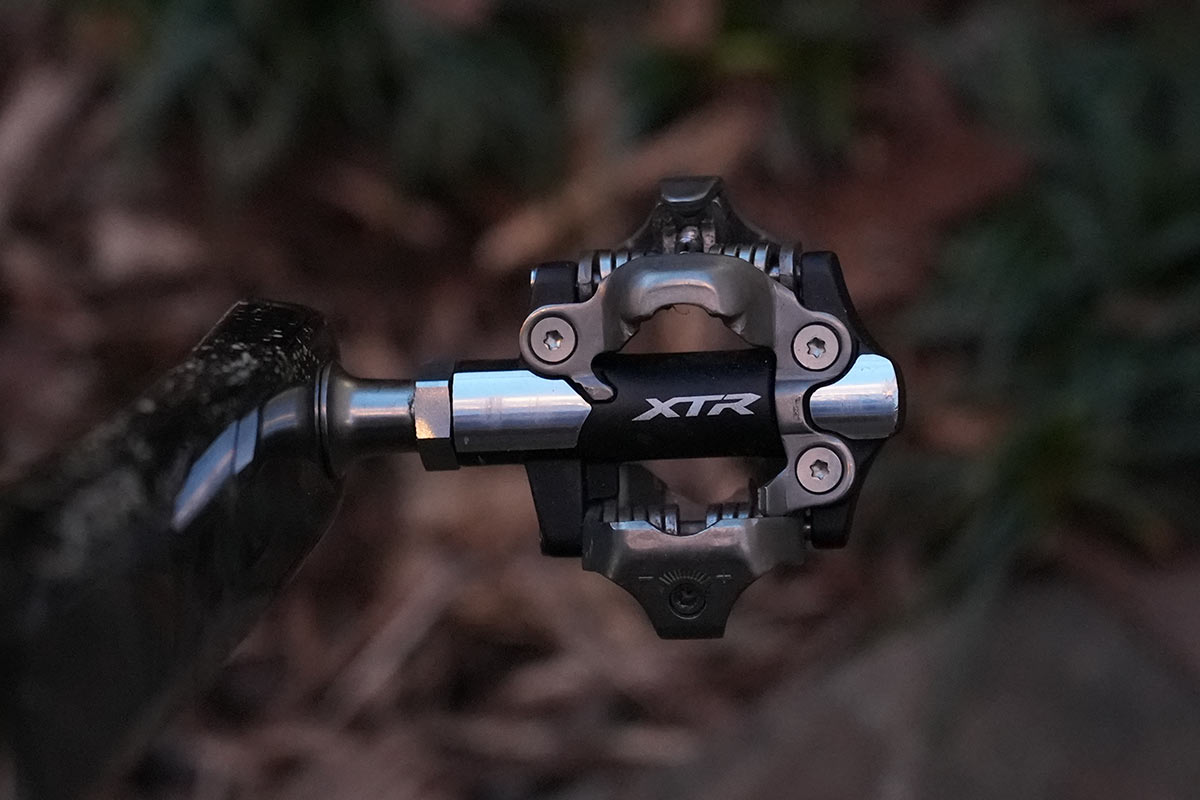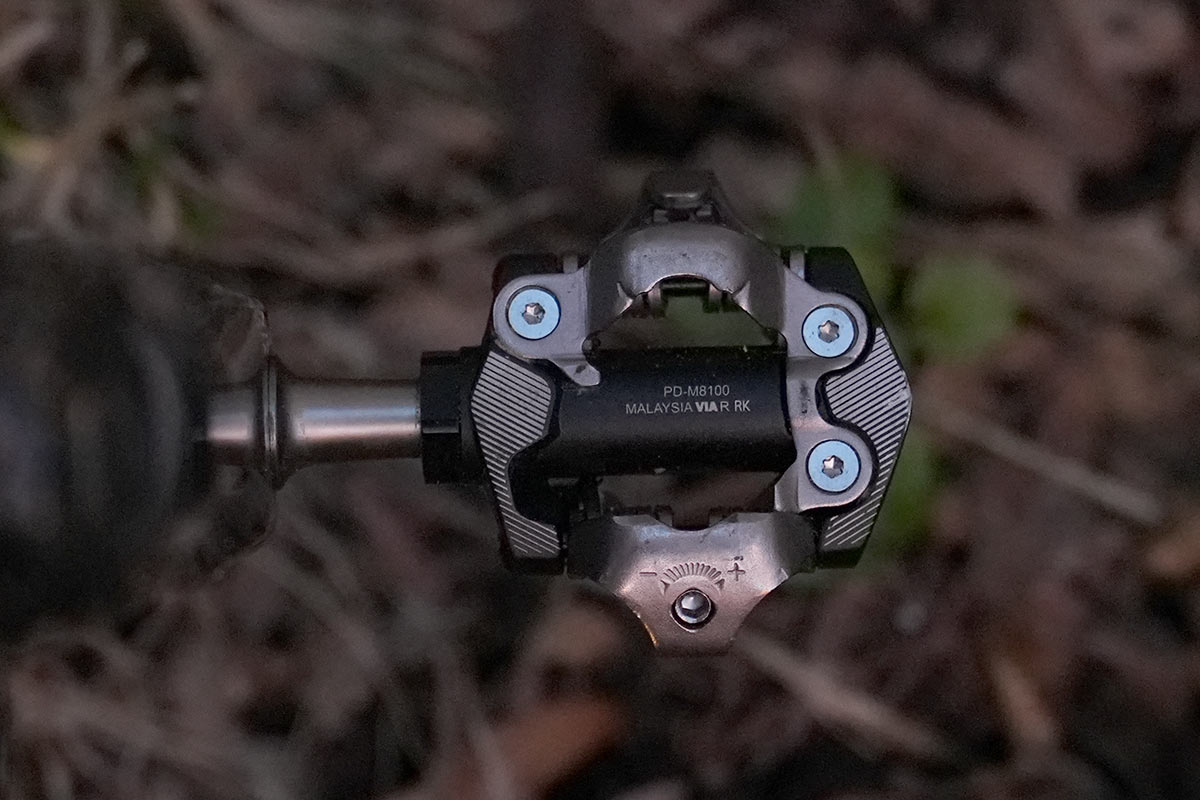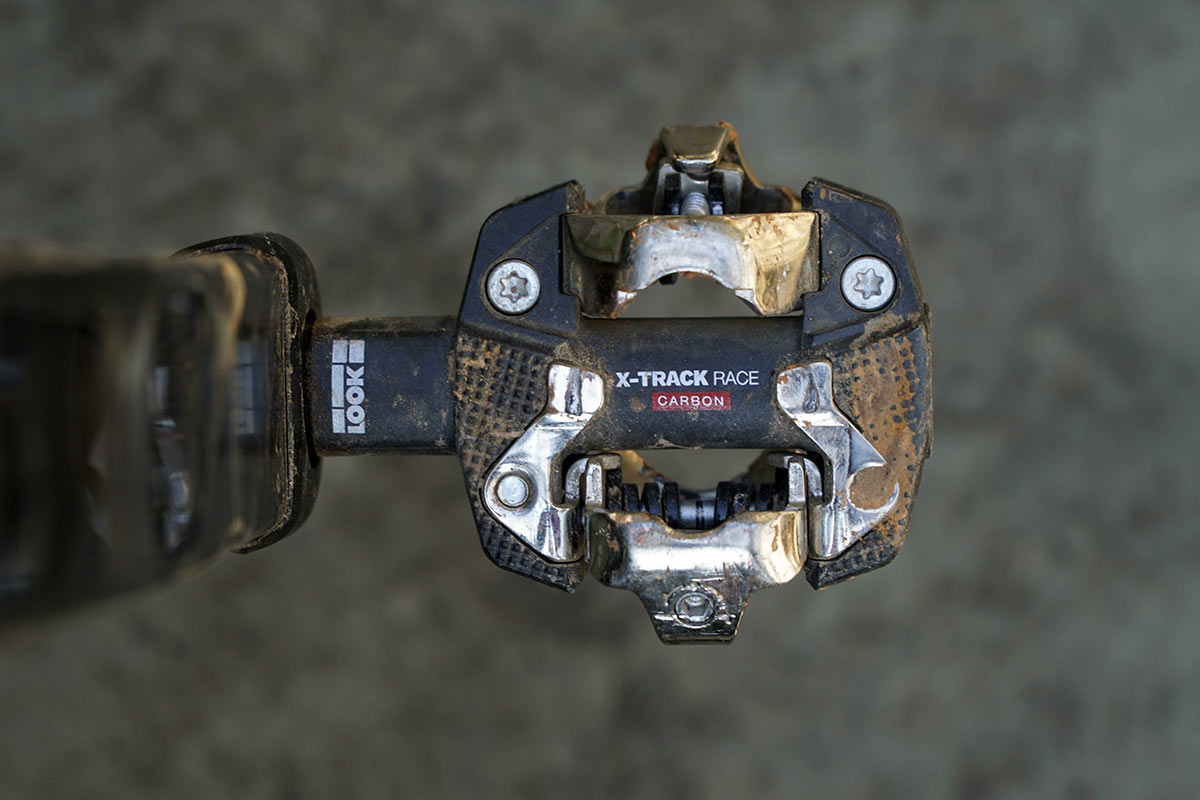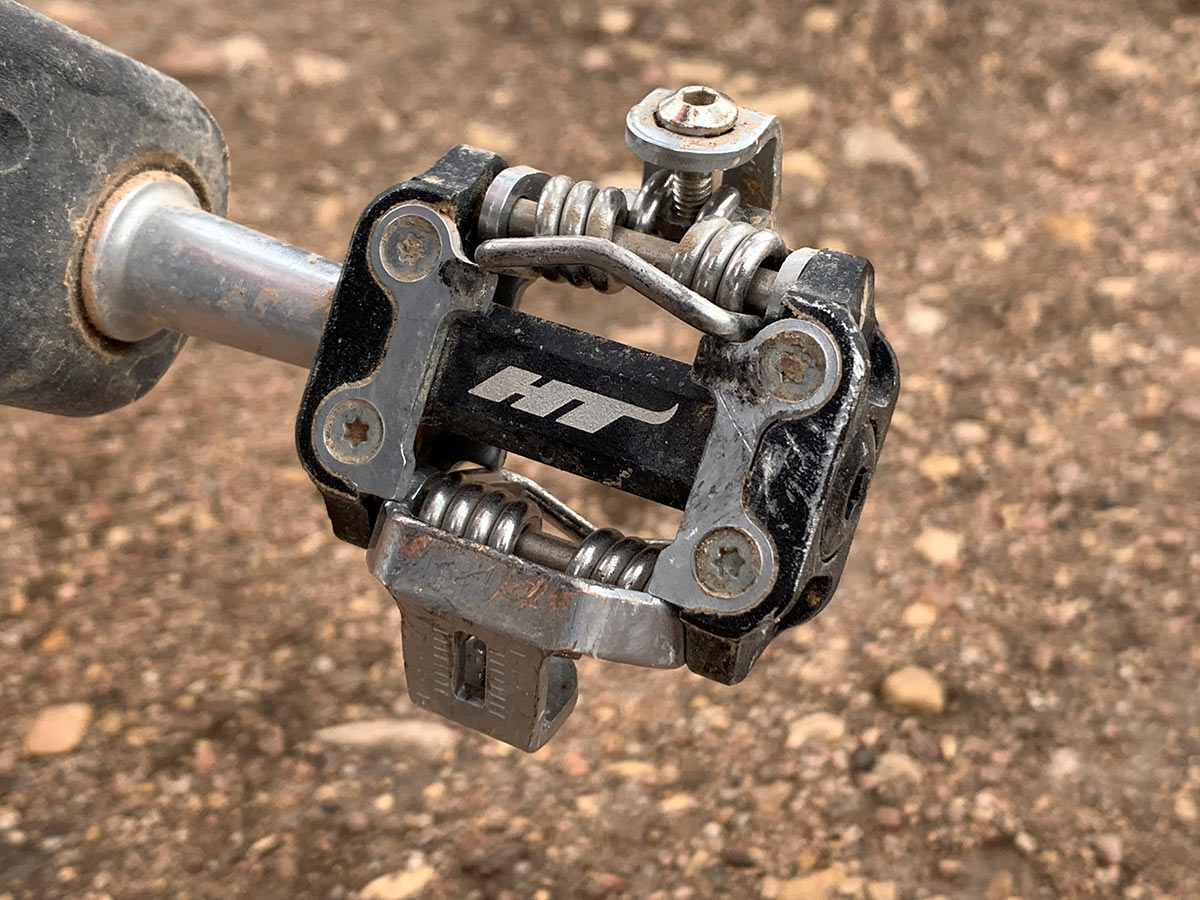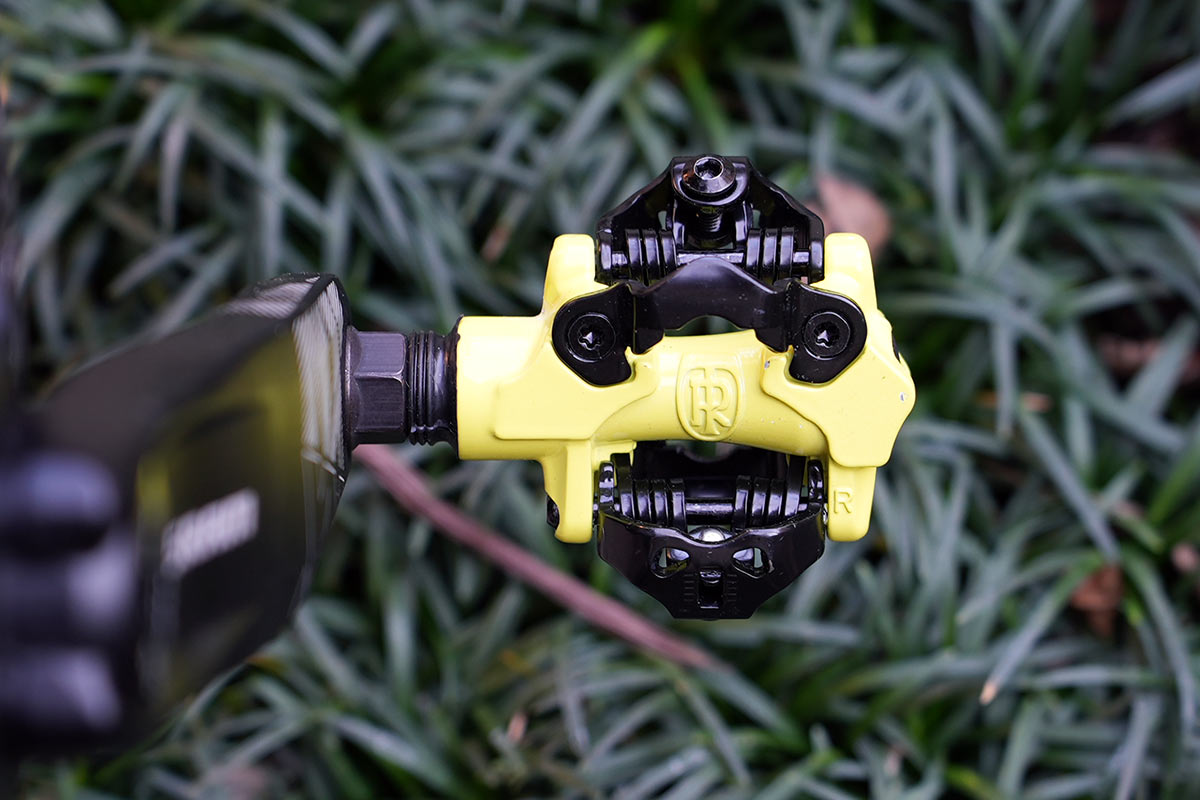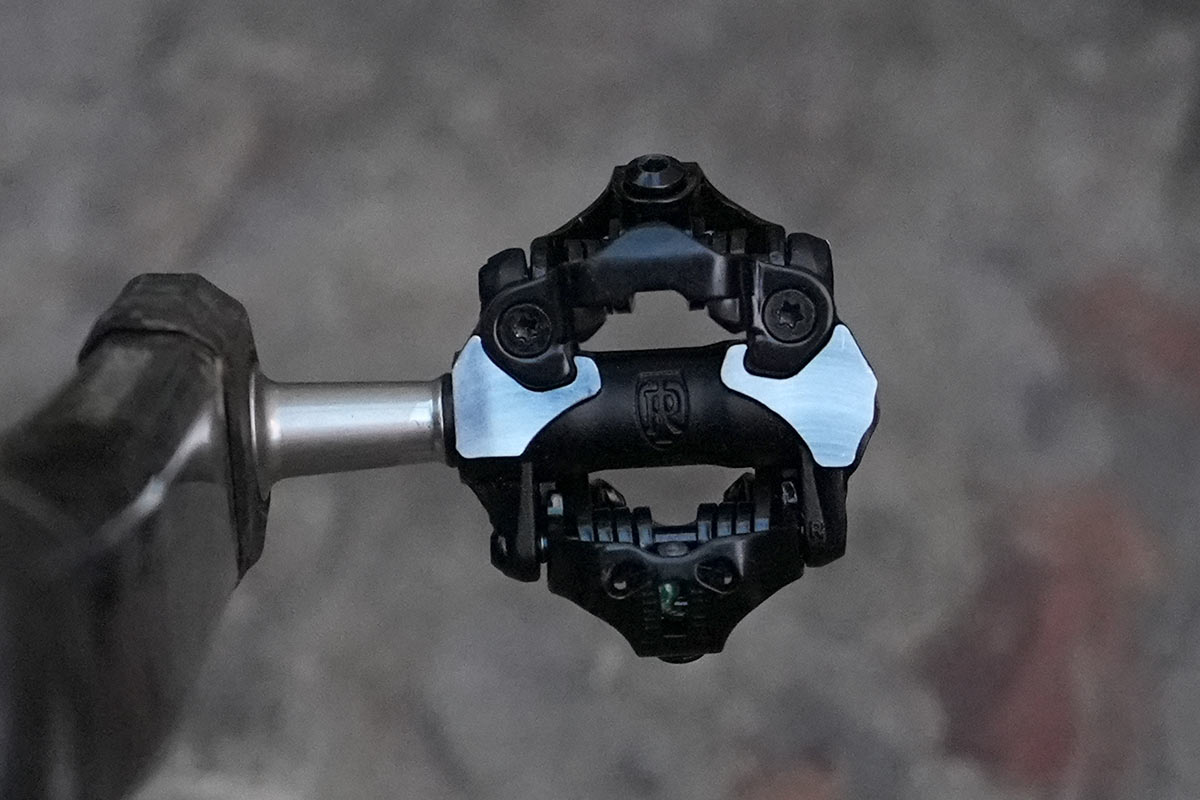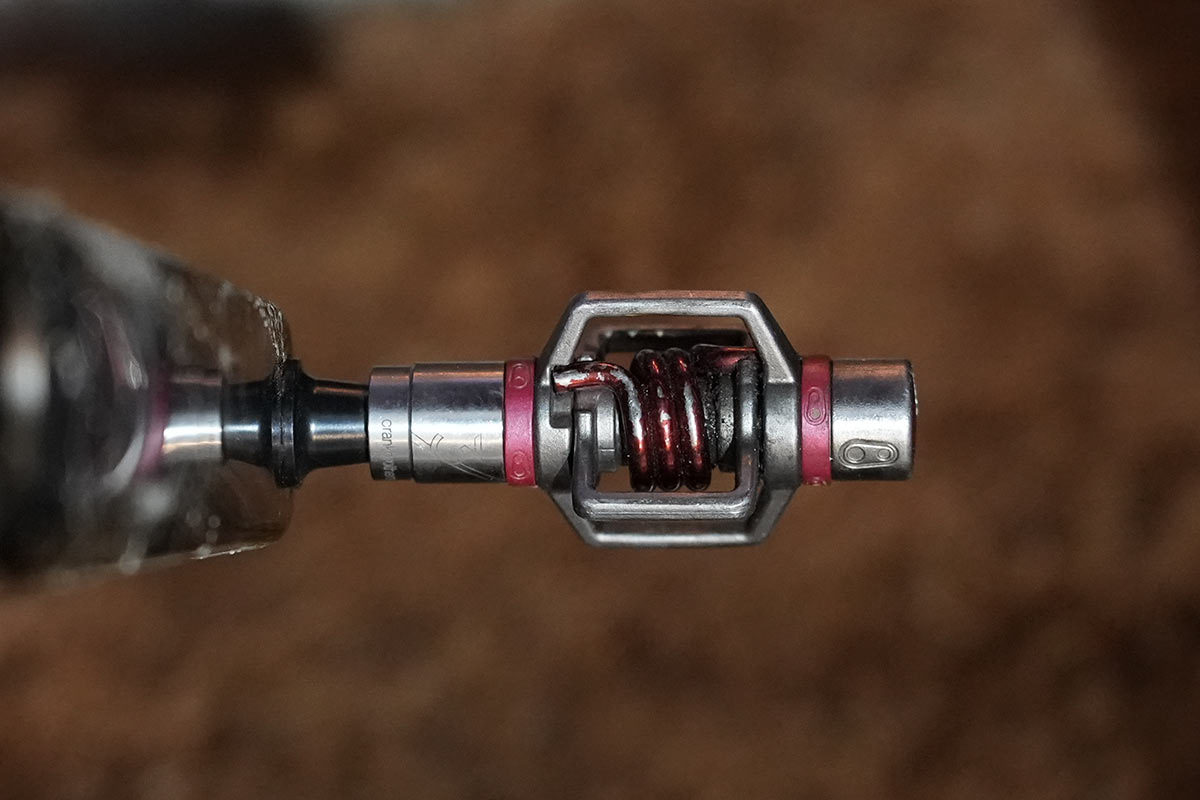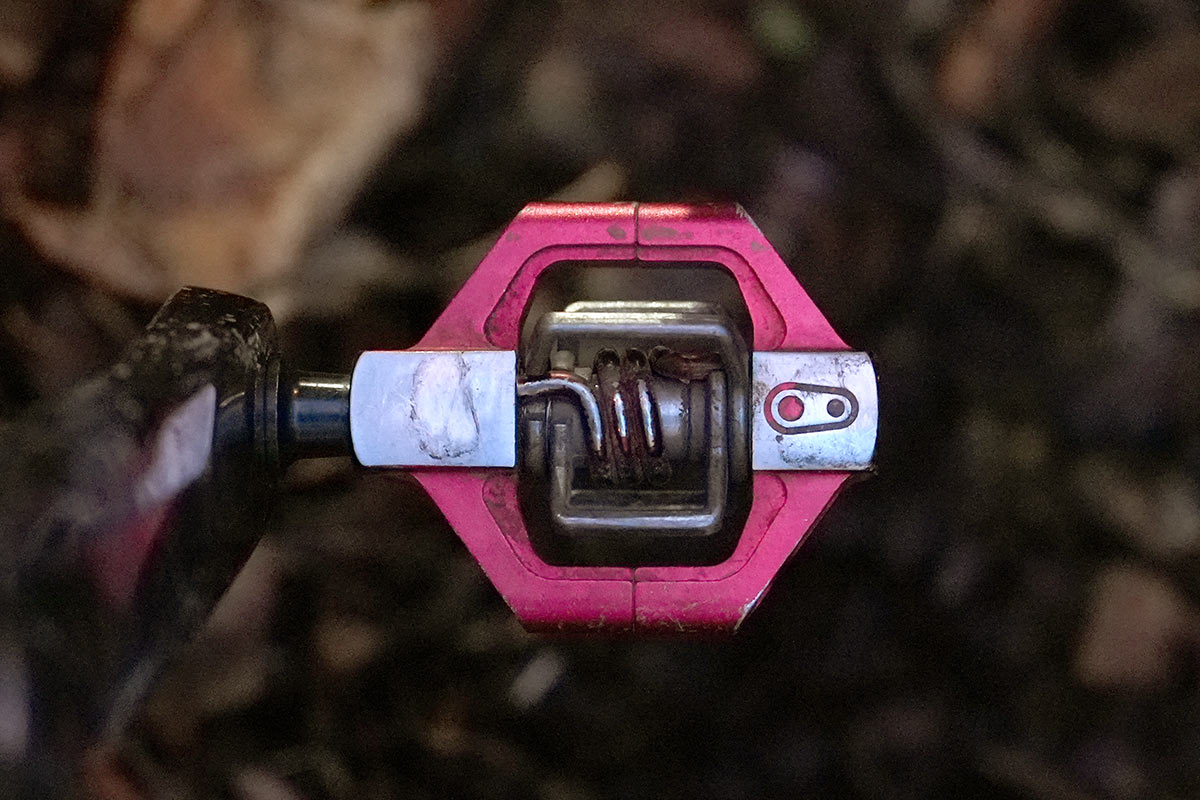The best mountain bike pedals are the ones that inspire confidence by holding your shoes securely over the roughest terrain, hold up to repeated abuse, and keep their weight reasonably low.
We’ve compiled our best picks for XC, Trail, All-Mountain, and Enduro riding, based on years of testing and hundreds (if not thousands) of miles on each one. Whether you’re looking for the lightest, the strongest, the tightest, or the biggest, this guide will help you find the best MTB pedal for your style of riding.
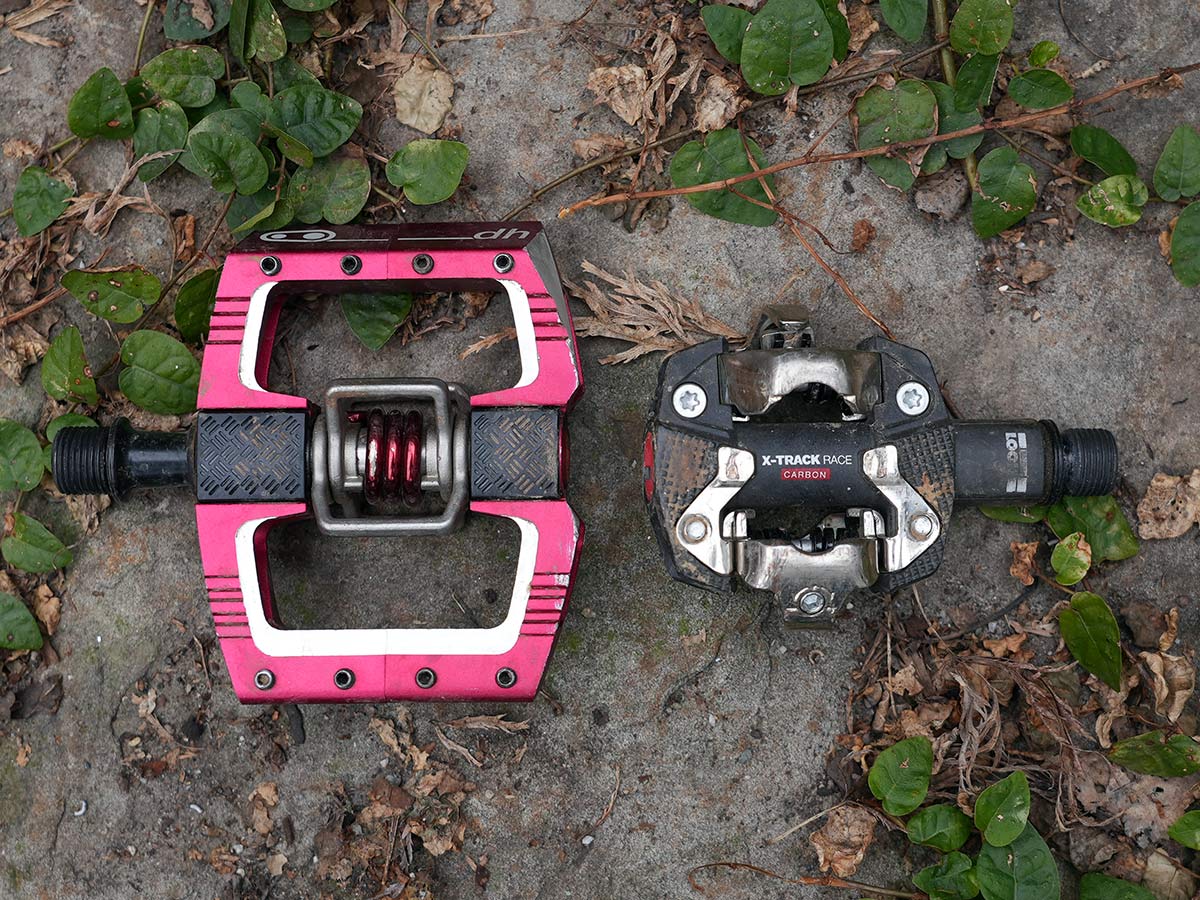
We’ve split this guide up into two groups – XC pedals without extended platforms, and Trail/Enduro pedals with platforms. We’re only including “clipless” pedals that use a cleat on your shoe to “clip” into the pedal…flat pedals are another story altogether.
We’ll start with XC pedals, but don’t let the category fool you…many of us use these smaller pedals for everything from pure cross country racing up to all-mountain riding. Scroll further down if you like something a little bigger, though.
Choosing the right pedal comes down to prioritizing weight, cleat float, support, and durability. For each, there are multiple price options, and we’ll note the tradeoffs between budget options and the high-end pedals in our list below.
Some may look similar at first glance, but the details matter. We’ll jump right into the best mountain bike pedals now. But for those who aren’t familiar with clipless pedals, scroll down toward the end of the article for explanations of the technologies, terms, and features you should know.
Here are our picks, starting with cross country and light trail…
The Best XC Mountain Bike Pedals of 2021
THE GOLD STANDARD: Shimano XT M8100 & XTR M9100 Pedals
Shimano basically invented the modern mountain bike pedal with its SPD interface. And they’ve been the go-to choice for many riders ever since. It’s hard to go wrong with XT M8100 and XTR M9100 pedals – they’re reasonably light, durable, and provide reliable, adjustable cleat tension.
Shimano is the only brand here that uses loose, angular contact (AKA “cup & cone”) bearings. This makes them easily user serviceable should they develop the play, which is good because they don’t offer a standard rebuild kit.
XT M8100: Below XT is the M540 SPD pedal, which has become something of a staple for basic, inexpensive clipless pedals. It’s only a few grams heavier than XT, but has virtually no platform and runs a narrow, standard steel bearing assembly inside.
In contrast, XT will offer more support thanks to small shelves on either side of the retention mech. Compared to the prior M8000 model, this M8100 pedal has slightly updated sealing and axle thickness, but they’re very similar. Read our full XT M8100 tech story here to see the rest of this group.
- Actual weight: 169g/pedal – 338g/pair
- Float: 4º
- Release Angle: 13º (with SM-SH51 cleat)
- Q-Factor: 55mm
- Bearing Type: Cup & cone adjustable contact bearings
- MSRP: $125
Check Price at Amazon
XTR M9100: XTR is Shimano’s flagship line, and this pedal improves upon XT by dropping about 30g per pair. Compared to the prior M9000 pedal, these get a wider, yet slimmer, platform that keeps weight the same as before, but actually supports your shoe better. Key upgrades from XT are a thinner profile (reduced stack height) and the option for standard or 3mm shorter axles for racers seeking the narrowest possible Q-Factor. Read our full XTR M9100 tech story to see the rest of this group.
- Actual weight: 157g/pedal – 314g/pair
- Float: 4º
- Release Angle: 13º (with SM-SH51 cleat)
- Q-Factor: 52mm or 55mm
- Bearing Type: Cup & cone adjustable contact bearings
- MSRP: $179.99
Check Price at Jeonson USA
FOR PEDAL MASHERS: Look X-Track Carbon XC Pedals
Look’s X-Track pedal lineup comes in four flavors, ranging from $50 to $270 per pair. We recommend something in the middle, like the Carbon XC model shown here. They’re 30g lighter than the base model, comparable in weight to XT, but have the largest platform of any pedal listed here. This provides excellent stability, making it the perfect option for people who want to stomp on the pedals hard, perhaps before they even get fully clipped in…like during a mass start when you’re gunning for that hole shot!
These have proven durable, thanks to a double row of cartridge bearings on the outer edge and a wide bushing closer to the crank arm. In fact, the placement of these are among the widest of any pedal, too, which provides better support for the platform itself. Read our full review of these pedals for more details.
- Actual weight: 175g/pedal – 350g/pair
- Float: 6º
- Release Angle: 13º
- Q-Factor: 53mm
- Bearing Type: Sealed cartridge plus metal bushing
- MSRP: $130
FOR WILD RIDERS: HT Components M1
The HT Components M1 comes in a whopping 11 colors, including an oil slick finish. So, you can get wild with your bike’s look. More importantly, you can get wild on the bike – HT has one of the highest retention ranges of anything we’ve tested. Despite their minimal appearance, they extend out from the retention mech enough to provide decent support. If you tend to use a lot of body english while riding and pop out of your pedals more than you’d like, give these a try.
Just make sure to use the X1 cleats that come with them if you want the tightest retention. They offer three additional cleats, ranging from 4-8º of float, one of which also lets you roll your foot out in addition to twisting. After a year of regular use, they developed a little play, but HT offers to rebuild kits to replace the worn bearings.
- Actual weight: 148g/pedal – 296g/pair
- Float: 4º, 4.5º or 8º depending on cleat
- Release Angle: 13º
- Q-Factor: Not specified
- Bearing Type: Sealed cartridge plus IGUS bushing
- MSRP: $129
FOR BUDGET RACERS: Ritchey Logic Comp & WCS XC Pedals
Ritchey offers two versions of their XC pedals, the budget-friendly Comp and high-end WCS, which comes in around the same price as most of the other pedals listed here. The latest version uses a much larger platform than the prior model and has a much more solid, premium feel.
RITCHEY COMP XC: If there’s a winner for value, it’s the Ritchey Comp XC. Compared to the WCS model shown below, cost savings come from using a cast alloy body, hefty CroMo axle, and a standard pair of steel bearings inside. What makes them stand out is that they’re cheaper than Shimano’s M540 pedals, yet offer more platform and a lower stack height, making them very beginner-friendly. Plus, they’re the same weight as XT, and they come in six colors.
- Actual weight: 169g/pedal – 338g/pair
- Float: 4º
- Release Angle: 16º
- Q-Factor: 52.5mm
- Bearing Type: steel cartridge
- MSRP: $56.95
RITCHEY WCS XC: The WCS pedals machine away grams to save weight. A sleeker Chromoly axle and upgraded bearing setup gives them an incredibly low 15.5mm stack height! Inside is the triple threat of a bushing, needle bearing, and sealed cartridge bearing, providing solid, free-spinning performance.
Unlike the Comp model, the WCS has a bearing rebuild kit available to keep them rolling fast and fresh year after year. If you’re looking for the lowest stack height from a brand that’s been around since the dawn of MTB, the WCS pedals offer top-level performance at a fair price.
- Actual weight: 154g/pedal – 308g/pair
- Float: 4º
- Release Angle: 16º
- Q-Factor: 53mm
- Bearing Type: bushing + needle bearing + sealed cartridge bearing
- MSRP: $122.95 (WCS)
FOR WEIGHT WEENIES: Crankbrothers Eggbeater 3
The Eggbeaters are unique in that they offer four-sided entry. Just step down on them (not the usual slip-in-from-behind clip in movement) and their wings will grab the cleat. The open design means there’s basically no way they’ll get clogged up with mud or snow.
They’re the lightest pedals on the market but also have the least supportive feel. There’s essentially no platform, but they do offer Traction Pads that slide onto the body on either side of the “wings”, giving you a bit better feel on shoes with lower profile tread blocks.
It’s not just the pedals that are light (their Ti version is under 90g/pedal!), the cleats (30g) are about half the weight of others, too. But that’s because they’re brass, so they wear faster. And you’ll basically need to use their shoe shields to avoid having the wings dig into your carbon soles:
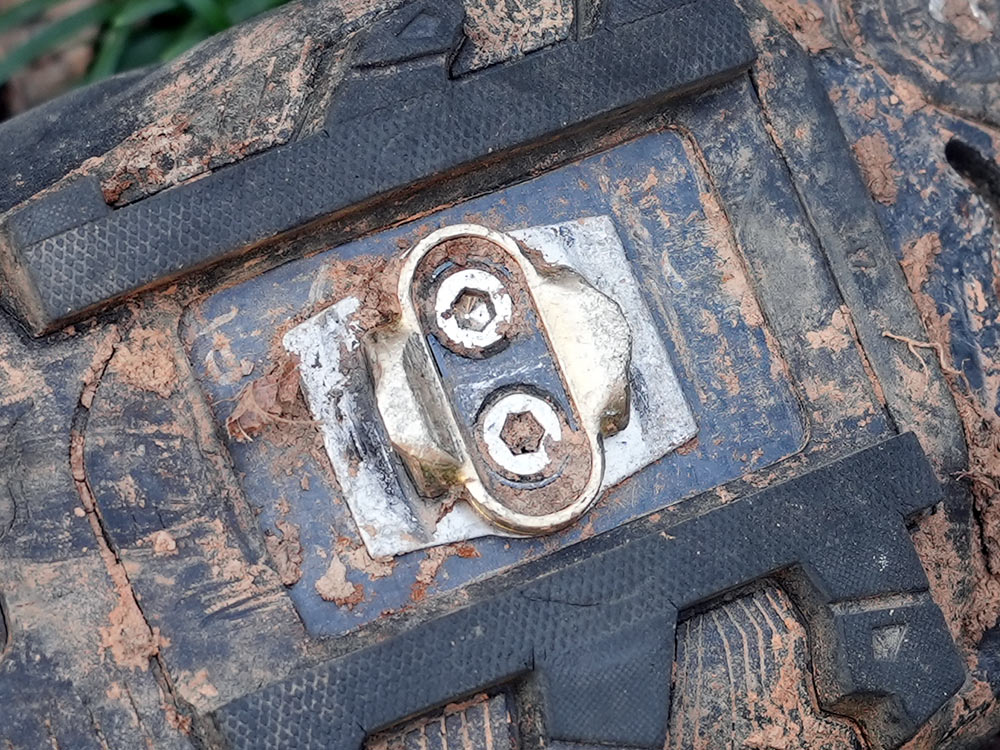
It seems that people either love Eggbeaters or hate ’em. If you smash a rock on the downstroke, it can release the cleat and pop your foot out. And, though rare, it’s possible to roll your foot off the front of them under extreme efforts.
The upside? Their cleats are left/right-specific, giving you the ability to choose between 0º or 6º of float. They’re also easily rebuildable. Key reasons to upgrade from the Eggbeater 2 to the Eggbeater 3 are stainless steel wings, a tooled alloy end cap, and better Enduro Max bearings inside…and they’re 5g lighter for the pair.
- Actual weight: 140g/pedal – 280g/pair
- Float: 0º or 6º
- Release Angle: 15º
- Q-Factor: 52mm
- Bearing Type: Igus LL Glide Bearing & Enduro Max cartridge bearings
- MSRP: $139.99
The Best Trail & Enduro Mountain Bike Pedals of 2021
Here are our picks for the best clipless pedals with platforms. We’ve listed them from least to most aggressive, meaning the pedals at the top are either smaller or lack pins or both. The point is, it’s the combination of platform shape and size, and whether it has nubs or pins, that set a particular pedal’s level of support and grip.
A bigger platform offers more support, but it adds weight and might end up catching rocks and logs more often. You’ll notice some angled shaping for some, which typically helps them avoid clipping the ground or at least improving their ability to glide off of impacts rather than getting caught on them and pitching you off the bike.
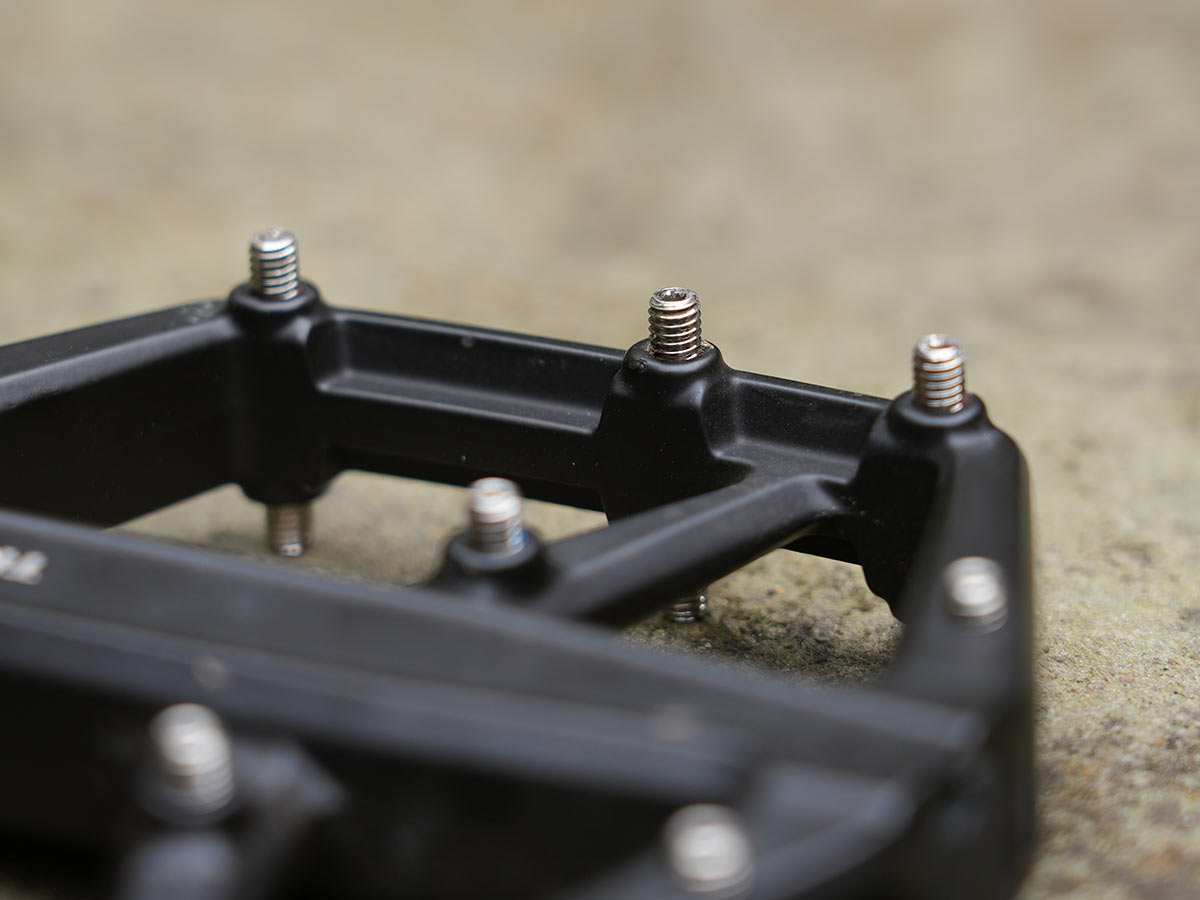
The pins are usually adjustable and replaceable, with some pedals offering different heights to help you customize the grip. Other pedals have small nubs or bumps in lieu of pins, which offer less grip, but are also less likely to rip your shins open.
Some trail pedals skip the pins, though, simply using larger platforms to increase support without hampering your ability to twist your shoe out…which is an important consideration for newbies: Aggressive pins are there to hold your foot in place and can make it harder to twist your shoe and release from the pedal.
FOR LIGHT TRAIL RIDERS: Crank Brothers Candy 3 Pedals
Bridging between an XC pedal’s size and the beginnings of a trail pedal’s platform, the Crank Brothers Candy pedals are the perfect option for riders who want to minimize weight but still want a little more substance under their feet.
With a platform that’s about the same size as most XC pedals, Candies have just enough area to stomp on while you’re getting going without the worries of rolling off the front if you miss clipping in on the first try. Like the Eggbeaters, you step down onto the pedals as opposed to sliding in at an angle.
Current models have a slightly broader platform surrounding the wings, we’ll be testing those shortly and update the pics. But the internals haven’t changed, and these are just as easy to rebuild and use the Eggbeaters, just with a little more meat on their bones.
- Actual weight: 157g/pedal – 314g/pair
- Float: 0º or 6º
- Release Angle: 15º
- Q-Factor: 52mm
- Bearing Type: Igus LL Glide Bearing & Enduro Max cartridge bearings
- MSRP: $139.99
FOR FAST PEDALERS: Shimano M8120 Trail Pedals
Like their XC counterparts, the Shimano XT and XTR “Trail” pedals use angular contact bearings and Shimano’s reliable, proven retention mechanism with crisp cleat engagement adding confidence over sketchy sections while the audible ‘pop’ on release confirms disengagement. A good range of retention adjustments should suit all but the most wiggly or aggressive riders.
As shown above, the latest XT PD-M8120 trail pedal’s design offers an improved shoe contact area, providing plenty of added stability on technical terrain without feeling heavy or getting in the way, and has increased clearance for mud/snow.
As with most Shimano pedals, some taller lugged shoes may require a shim under the cleat to perform properly, but we tested these pedals with Giro, Specialized, Fizik, and 45NRTH shoes with no shim needed. After smashing 500+ miles of singletrack around the midwest with zero issues, we expect these to last a long time with little maintenance.
- Actual weight: 215g/pedal – 430g/pair
- Float: 4º
- Release Angle: 13º (with SM-SH51 cleat)
- Q-Factor: 55mm
- Bearing Type: Cup & cone adjustable contact bearings
- MSRP: $125
FOR ALL ‘ROUNDERS: Look X-Track EN-Rage Plus
Compared to Shimano’s trail pedals, the LOOK X-Track EN-Rage Plus gets a broader 67mm platform, and adds two pins at the front. This offers more support, and a bit more grip for trail shoes with a broader tread patch. If you regularly put a foot out when cornering hard, these will help keep you planted as you’re clipping back in over rough terrain.
They’re almost twice as expensive as the standard EN-Rage pedal (which is also a bit narrower and loses the pins), but these Plus versions have a stronger forged aluminum body to handle more abuse.
- Actual weight: 224g/pedal – 448g/pair
- Float: 6º
- Release Angle: 13º
- Q-Factor: 53mm
- Bearing Type: Sealed cartridge plus metal bushing
- MSRP: $130
FOR RIPPERS: HT Components T1 Pedals
The HT Components T1 looks smaller than the others, but in reality, it’s just leaner without giving up the support you need for getting rowdy. It comes in 14 different colors, and like the M1, it has one of the highest retention ranges available and offers three different cleats to fine-tune your float and release angles.
Two adjustable pins on the front keep shoes from sliding around during on-again, off-again tech sections and corners, and slotted rear sections help prevent slipping. We’ve done a number of all-day rides on these, in a wide range of conditions and terrains, and never had any complaints about foot comfort or performance. Rebuild kits are available to keep them spinning freely.
- Actual weight: 183g/pedal – 366g/pair
- Float: 4º, 4.5º or 8º depending on the cleat
- Release Angle: 13º
- Q-Factor: Not specified
- Bearing Type: Sealed cartridge plus IGUS bushing
- MSRP: $135-$159 depending on the color
FOR BIG BIKE STOMPERS: Crankbrothers Mallet DH Pedals
Now we’re getting into some proper enduro-level, bike park-worthy pedals. Unlike the smaller pedals you’ve seen so far, the Crankbrothers Mallet E and DH series use a concave platform shape. This means it’s shallower in the middle, which helps keep your shoe planted on the pedals as you smash through oversized technical sections.
The key difference between the Mallet E (Enduro) and Mallet DH (Downhill, shown) is platform size and pin count, the latter being bigger with more pins. But the premise is the same, as are the internals. Unlike the other CB models, the Mallet only gets two spec levels – standard and titanium. Unless you’re made of money, go with the standard versions as they already come with the upgraded LL Igus bushing and Enduro Max bearings.
We’ve run the DH version and appreciate the extra grip that eight adjustable pins (per side) offer, and the platform holds the entire forefoot rock steady…especially when paired with Crank Brother’s matching shoes. They’re about 25g heavier than the Enduro version, but unless you’re routinely leaning the bike far enough to scoop dirt in the corners, the extra grip and size here’s worth it since they’re the same price.
- Actual weight: 239g/pedal – 478g/pair
- Float: 0º or 6º
- Release Angle: 15º
- Q-Factor: 52mm
- Bearing Type: Igus LL Glide Bearing & Enduro Max cartridge bearings
- MSRP: $169.99
FOR RIDING IN MUD & SNOW: Time ATAC MX-series Pedals
Time pedals’ wide-open spring mechanism self-clears in almost every condition, even when packed with snow and ice, making them the gold standard for sloppy conditions. And our go-to winter fat biking.
But there are two more features that make Time’s mountain bike pedals unique. First, they offer both rotational and lateral float, making them easier on the knees (another benefit for fat bikes with wide q-factors). It can feel a bit strange to riders coming from pedals that are more ‘locked in’, but it’s nice once you’re used to it.
Second, the spring mechanism faces forward. On their smaller ATAC XC pedals without any platform can sometimes feel like your foot will roll off the front during sloppy (or frantic!) attempts to clip in, but not all of us share that experience. But with the MX pedals’ platform, it’s not an issue at all.
The MX-series pedals use Time’s rounder spring shape (versus the harder-edged, firmer feeling spring on their Speciale enduro pedals, which are a better option for aggressive dry-conditions riding) which are best for wet, muddy and snow-covered riding.
Time offers four levels of MX pedals (2/4/6/8), with different materials and weight savings measures. The MX 8 shown here is the top of the line with a composite body and hollow steel axle, but they all function the same.
- Actual weight: 186g/pedal – 372g/pair (for MX 8)
- Float: 5º
- Release Angle: 13º or 17º
- Q-Factor: N/A
- Bearing Type: Steel cartridge bearings
- MSRP: $130 (for MX 8) (amazon)
Why you should trust us
We ride a lot, in a lot of different conditions…from sloppy wet to desert dry, baking sun to freezing snow. We’ve raced on many of these pedals, and ride every brand here nearly daily. These pedals represent the best of what we’ve ridden over the years, with notes on what’s new for the current generation of pedal offered.
In most cases, there are models above and below these, offering similar features for more or less money. Typically, more expensive models will use stronger or lighter materials and premium finishes or bearings. Less expensive models are usually heavier and less fancy. But we like these brands because the actual performance of the entry-level up to the top models is fairly similar, you just pay more to save weight and sometimes improve long-term durability.
Clipless Pedal tech & features explained
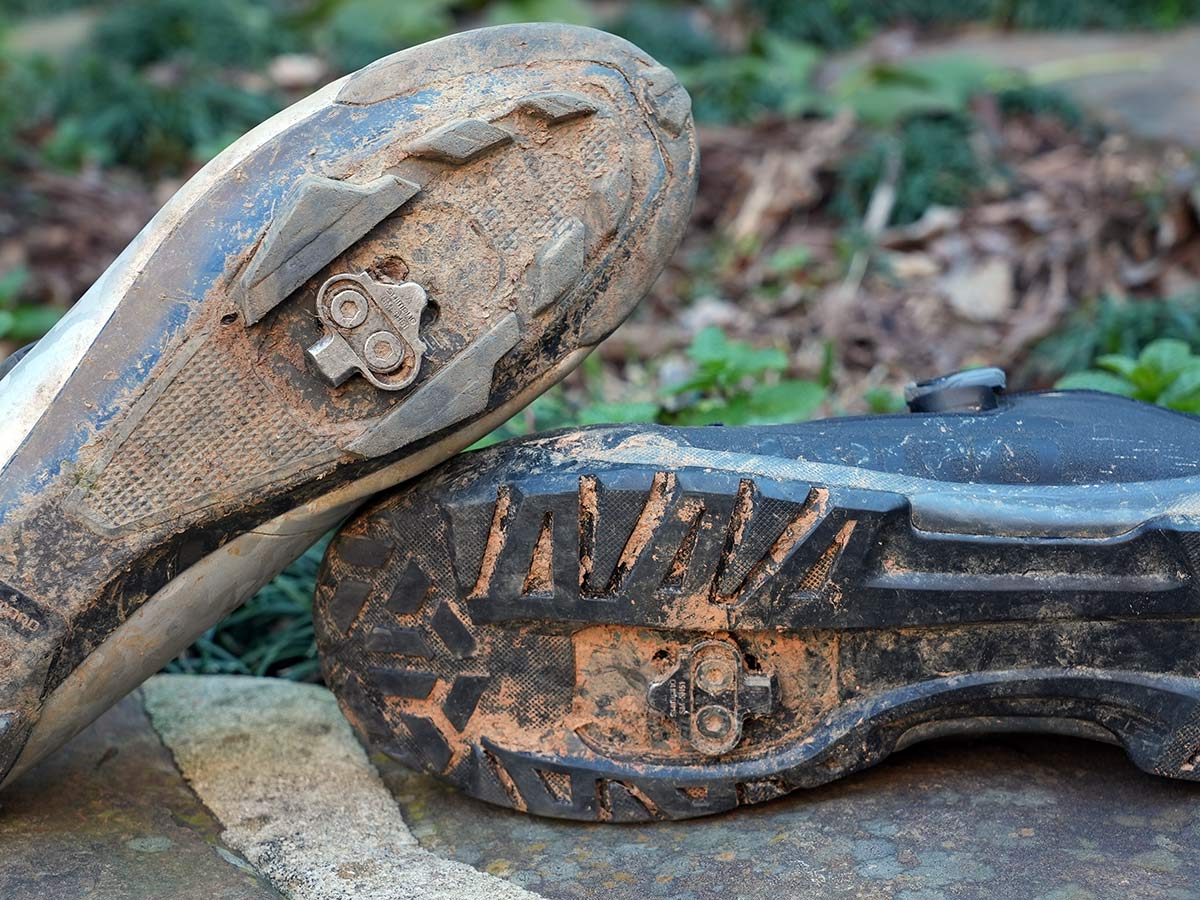
At the most basic level, they’re called “clipless” pedals because they lack the toe straps (aka “clips”) that served as a beginner’s way to keep your feet from sliding off the pedal on rough terrain. With these, you “click” a cleat into the pedal, which holds your foot securely so you can pedal more efficiently…and not worry about coming off the pedal when hit a big bump.
The main features of a clipless pedal are the retention mechanism, the body or platform, the spindle, and the bearings or bushings that it spins on. Virtually every modern pedal made for “performance” riding uses an 8mm hex wrench interface on the back of the spindle.
Cheaper pedals may use a 6mm hex bolt, or a 15mm wrench interface that you access from the outside of the crank arm. Chances are, if you’re reading this, you’ll only need an 8mm Allen wrench to install your pedals.
Clipless pedal terminology
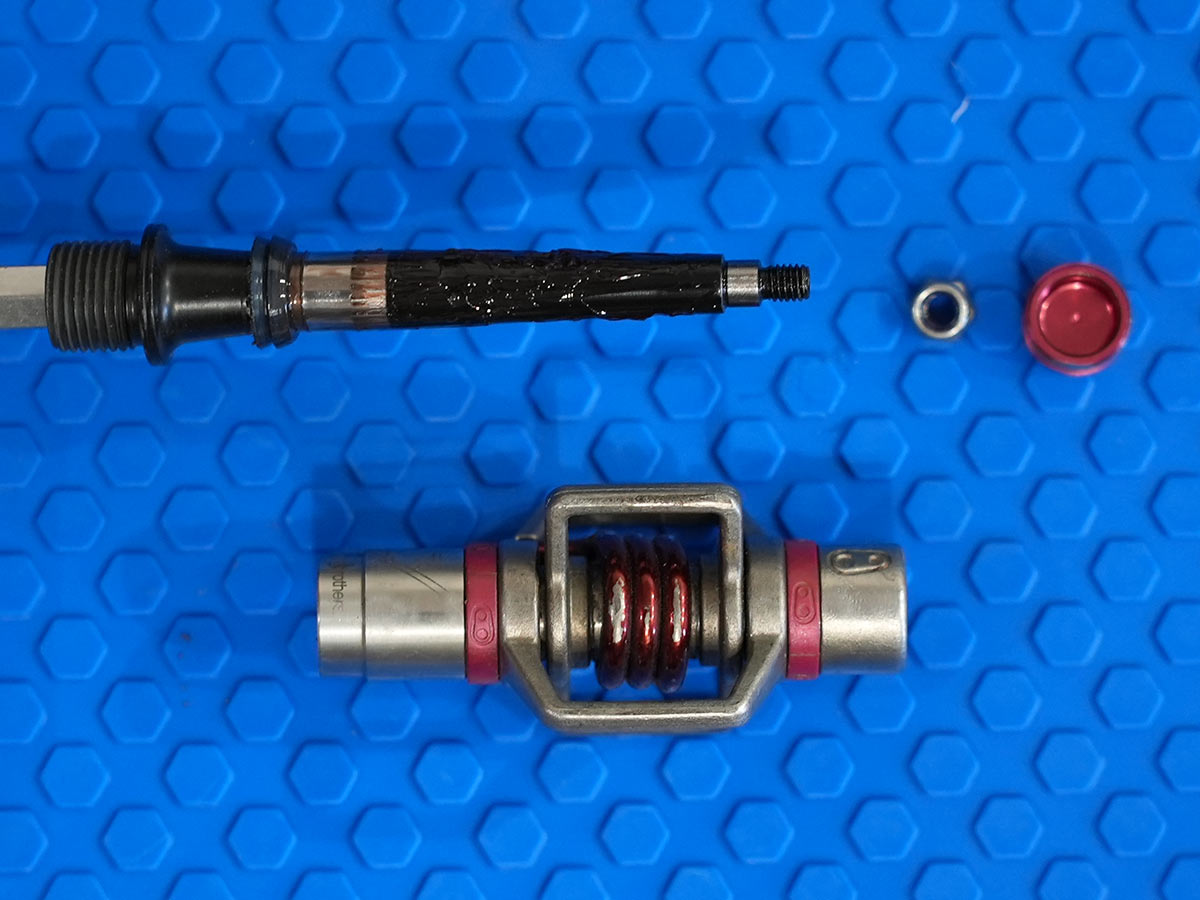
If you’re new to clipless pedals, or just wondering how “clip in” mountain bike pedals work, here are the terms and features you should know:
Bearings & Bushings – Between the pedal’s body and its spindle are bearings or bushings, or a combination of both. Bearings can be loose, sealed cartridge, or needle bearings. Bushings, usually from Igus, are lighter and work great, but can wear out faster, especially if water, dust or dirt gets past the seals.
Cleat – The part that mounts to your shoes. Some brands offer multiple cleat shapes to provide more or less float on a given pedal. We don’t list the individual cleat weights below, but most are steel and come in around 60-65g/pair, with bolts & hardware.

Float – The ability for your shoe to rotate laterally (meaning, your heel can rotate left to right) atop the pedal. A little float is good for keeping your knees from hurting, but too much can feel “loose”, like you’re not well-connected to the pedal.
Release Angle – This is how far you need to twist your heel outward in order for it to release your cleat from the pedal’s grasp. In the graphic above, the “Float” is freely floating and the cleat does not start pressing against the retention spring. Past the free float range, the cleat will start pressing back against the retention spring, but won’t push it far enough to release until it hits 13º of rotation in either direction.
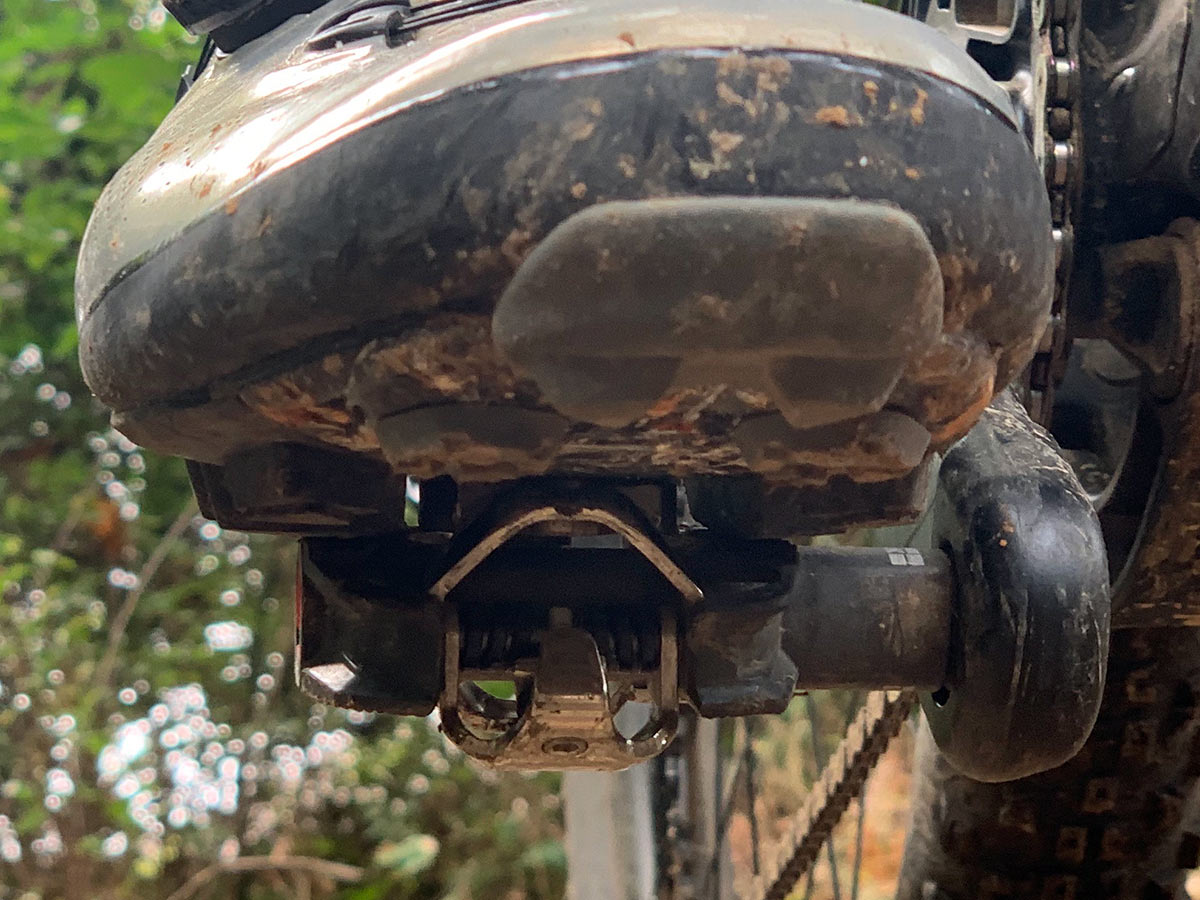
Platform – AKA, the body of the pedal, this is the platform that you stand on. Its size and shape determine how much stability and support the pedal offers. A larger platform gives you a sturdier body to stomp on in those finish-line sprints. XC pedals have the smallest platforms, which saves weight, but some designs offer more support than others.
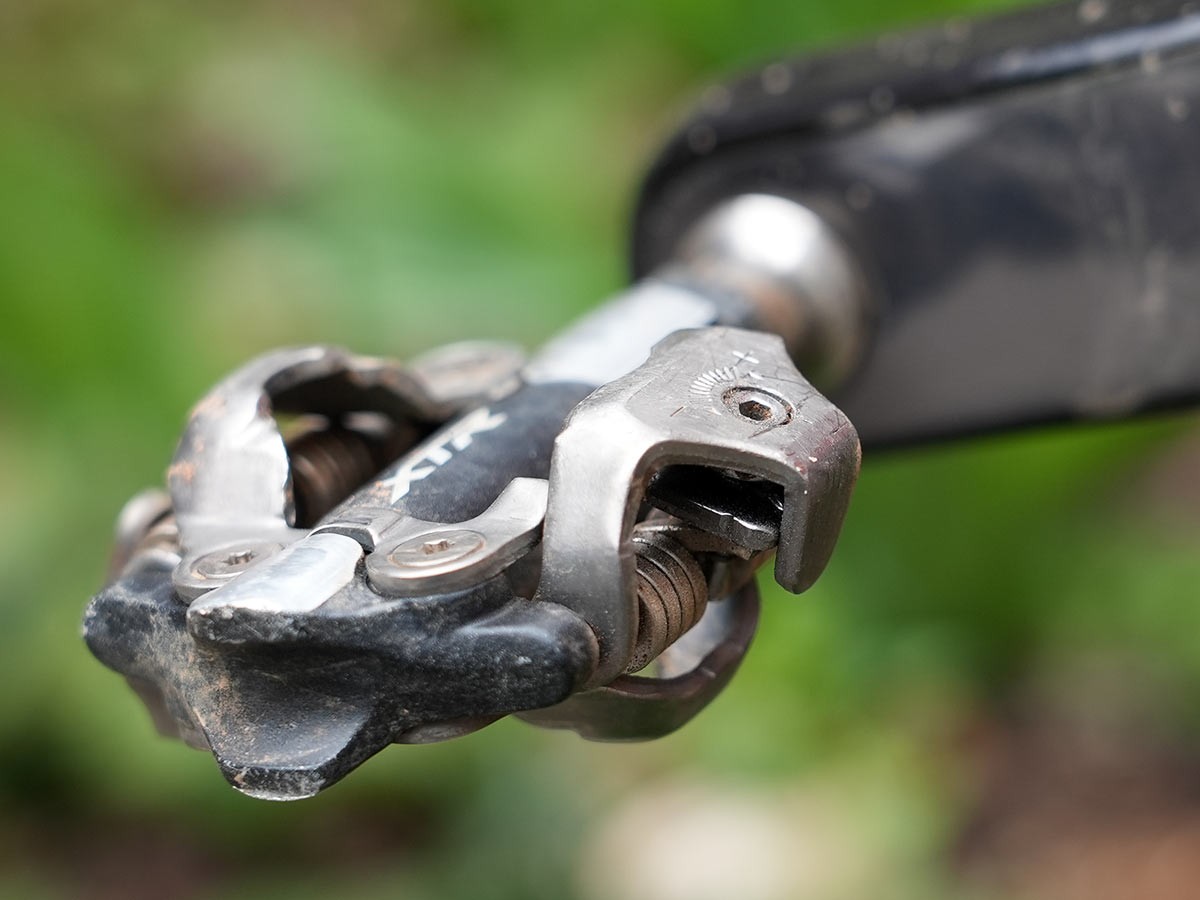
Retention – Your cleats are held in place (“retained”) by a spring-loaded mechanism. All but the Crank Brothers pedals allow you to adjust the retention force to make them easier or harder to get out of.
SPD – It stands for Shimano Pedaling Dynamics, and is the most common cleat-to-pedal interface on the market. You’ll find a lot of “SPD compatible” options from other brands, and many of the pedals listed here use a variation on it that’s quasi-compatible.
Spindle – The axle that the pedal spins on. They’re mostly steel, with Chromoly steel on mid-range and higher models. Some brands offer titanium upgrades that save a few grams, but double (or more) the price…and often have rider weight limits.
Stack Height – The “thickness” of your pedals plus the cleats, which creates a distance between the spindle and your foot. Your shoes’ sole adds to this, but having a lower stack height gives you a more planted “in the bike” feeling that gives you a better physical connection with the bike.
FAQ
What’s better – alloy, titanium, composite, or carbon fiber pedals?
The better question might be “what can you afford?”, but we’ll assume price is irrelevant. Metal, which for pedal bodies is going to be alloy, is going to be the most durable. But unless you’re constantly bashing your pedals on rocks, a high quality composite body should last the life of the pedals. Generally, “composite” means either glass fiber- or carbon fiber-reinforced composites…rarely do you find an actual “carbon fiber” pedal for mountain bikes.
How long do the best mountain bike pedals last?
Trick question, really. Average riders heading out for a couple of spins per week should get years out of them with proper maintenance. That means pulling them apart 1-2 times per year, cleaning, and re-greasing them as needed…with the right type of grease.
If you ride more often, are heavier or more aggressive, or constantly ride in crappy conditions, you’ll definitely want to get a pedal that offers an official rebuild kit.
How often should I replace my MTB cleats?
Normal steel cleats should be replaced once a year at least, more if you ride more often or in wet, gritty conditions. If you start unclipping too easily or accidentally, that’s a good sign you need fresh cleats. Crank Brothers and Time cleats will wear faster because they’re brass, which is a lot softer than steel. The good news on that, though, is they’re lighter and they won’t wear down the retention mechs on your pedals.
Which mountain bike pedal should I buy?
It kinda depends on your riding style. Racers tend to want the lowest stack and narrowest Q-factor, but also the lightest weight. So, you need to prioritize because none of the pedals above deliver all three. Let’s consider each aspect:
Q-Factor: If your bike has wider chainstays, an ultra-narrow Q-factor (which results from a shorter pedal spindle) could cause your heels to rub the stays. So, if you’re already running XTR cranks with their narrowest option, and your bike’s stays are stout or you have a bike with SuperBoost rear axle spacing, you may not want the pedals with the narrowest Q-factor.
Light Weight: Saving grams normally comes with a tradeoff, but not so much with pedals. Unless you’re popping an extra $200 or so for the titanium spindle options on Time, Look, HT or Crank Brothers, none of the pedals here have rider weight limits. Even then, the minute weight savings beyond a mid-range set of pedals is rarely worth the extra cash unless it’s also upgrading their quality or durability. If you’re only looking to save weight, there are more cost-effective ways to do that.
Stack Height: Imagine walking in platform shoes, then switching to minimalist barefoot shoes, and you’ll get the idea of why stack height matters. Lower will help you feel like you’re “in the bike” as opposed to “on” it. They’ll give you a lower center of gravity, albeit only a couple millimeters at best. But it’s noticeable. The only caveat is that lower stack height generally means thinner bearings and spindles, so if you’re a heavier or rougher rider, this might not be the most important factor in pedal selection.
Beyond these three considerations, think about how much you move around on the bike. Higher retention strength will be better for more aggressive riders. Efficient, steady, and lighter riders might prefer a less aggressive pedal like the Eggbeater. And those riding in foul conditions or snow should prioritize pedals, like Time, that can quickly clear and remain easy to clip into.
